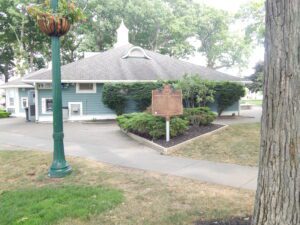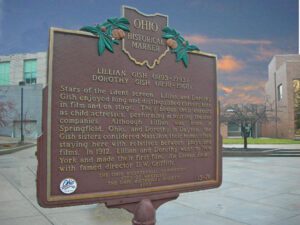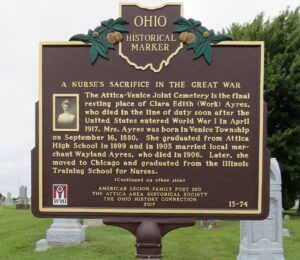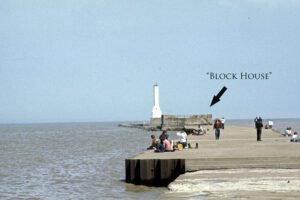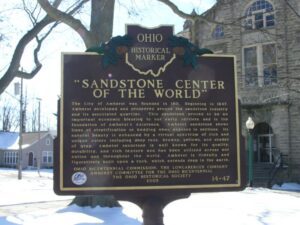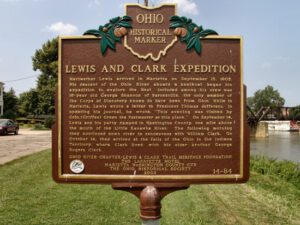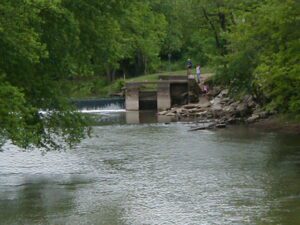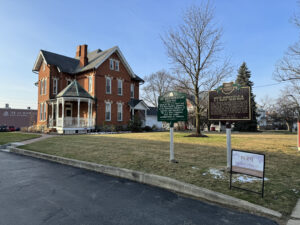, OH
Entrepreneur and philanthropist Joseph (Jose) de Rivera was born in Barcelona, Spain, and built an import business in New York City. In 1854, he bought six Lake Erie Islands and had South Bass Island surveyed and subdivided into ten-acre lots. De Rivera traveled between New York and South Bass Island, initially turning Put-in-Bay into a sheep farm. He encouraged settlement on the island and its wine industry by helping German immigrants purchase land to plant vineyards. He donated five acres for this waterfront park, the site for the first school, and the land for the first church. To promote travel to the island, de Rivera opened the island’s largest cave as a tourist attraction. He is buried in the island’s cemetery, which is on land he donated for that purpose.
, OH
Stars of the silent screen, Lillian and Dorothy Gish enjoyed long and distinguished careers both in film and on stage. They began their careers as child actresses, performing in touring theater companies. Although Lillian was born in Springfield, Ohio, and Dorothy in Dayton, the Gish sisters considered Massillon their home, often staying here with relatives between plays and films. In 1912, Lillian and Dorothy went to New York and made their first film, An Unseen Enemy, with famed director D.W. Griffith.
, OH
The Attica-Venice Joint Cemetery is the final resting place of Clara Edith (Work) Ayres, who died in the line of duty soon after the United States entered World War I in April 1917. Mrs. Ayres was born in Venice Township on September 16, 1880. She graduated from Attica High School in 1899 and in 1903 married local merchant Wayland Ayres, who died in 1906. Later, she moved to Chicago and graduated from the Illinois Training School for Nurses. (Continued on other side)
, OH
Lake Erie commerce has played a central role in the development of Huron. Important among Huron’s maritime industries were shipbuilding and commercial fishing. The city’s shipbuilding industry dates to the first decades of the nineteenth century. Shipyards were located on the Huron River’s west bank, slightly north of this marker, and also upstream at Fries Landing. Among the vessels built at Huron were the Great Western, constructed in 1838 and the first lake ship to have above-deck cabins, and the Golden Age, which, at 286 feet, was the largest craft on the Great Lakes when built in 1886. Huron shipbuilding declined as the nineteenth century drew to a close. Commercial fishing emerged thereafter, serving as Huron’s economic cornerstone for over fifty years. Huron’s fishing enterprises included the Huron, Kishman, Scott, and Zimmerman fish companies. By 1950, however, polluted lake waters ravished the once-lucrative industry. Although shipbuilding and commercial fishing are no longer a part of Huron’s daily life, they each had a profound effect upon the community’s growth for nearly two centuries.
, OH
The City of Amherst was founded in 1811. Beginning in 1847, Amherst developed and prospered around the sandstone industry and its associated quarries. This sandstone proved to be an important economic blessing to our early settlers and is the foundation of Amherst’s existence. Amherst sandstone shows lines of stratification or bedding when exposed in sections. Its natural beauty is enhanced by a virtual spectrum of rich and unique colors including deep reds, browns, yellows, and shades of gray. Amherst sandstone is well known for its quality, durability, and rich texture and has been utilized across our nation and throughout the world. Amherst is literally and figuratively built upon a rock, which extends deep in the earth.
, OH
Meriwether Lewis arrived in Marietta on September 13, 1803. His descent of the Ohio River aboard a keelboat began his expedition to explore the West. Included among his crew was 18-year old George Shannon of Barnesville, the only member of the Corps of Discovery known to have been from Ohio. While in Marietta, Lewis wrote a letter to President Thomas Jefferson. In updating his journal, he wrote,”This evening was visited by Colo. [Griffen] Green the Postmaster at this place.” On September 14, Lewis and his party camped in Washington County, one mile above the mouth of the Little Kanawha River. The following morning they continued down river to rendezvous with William Clark. On October 14, they arrived at the Falls of the Ohio in the Indiana Territory, where Clark lived with his older brother George Rogers Clark.
, OH
Michael Uhrich, Sr. founded Uhrich’s Mill on this site in 1806. Uhrich emigrated from Pennsylvania in 1804 and became one of the first County Commissioners upon the formation of Tuscarawas County in February 1808. In 1833, the same year Mill Township was organized, Michael Uhrich, Jr. platted the town named Waterford, which became Uhrichsville approximately six years later. During the Ohio-Erie Canal period, Uhrich’s Mill – consisting of four wheels (one for sawing wood, one for wheat, and two for grinding corn) – became the focal point for nearly all grain produced in the Stillwater Valley and shipped to Cleveland markets via the canal.
, OH
The Root Homestead was built in 1879 by Amos Ives Root, founder of the A. I. Root Company, shortly after he moved his business from the town square. The homestead housed several generations of the Root family until 1953 and was listed on the National Register of Historic Places in 1975. A pioneer of the beekeeping industry, Root helped to standardize such beekeeping equipment and tools as the Langstroth removable frame hive and the centrifugal honey extractor. As a result, beekeepers were able to harvest more honey every season without harming the bees. A prolific author and publisher, Root educated beekeepers across the globe and built a sense of community within the profession. (Continued on other side)


